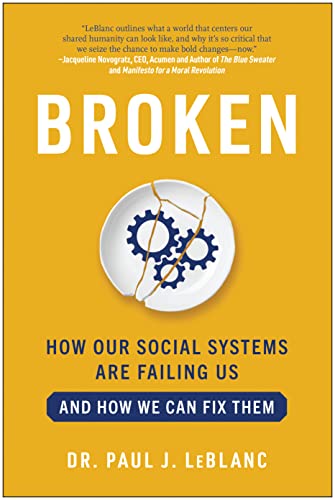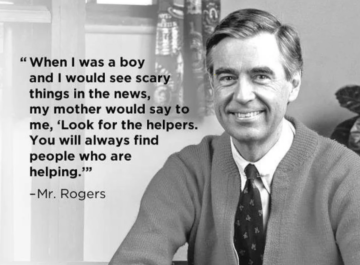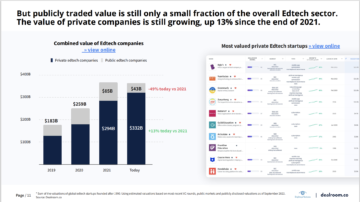
I’ve been waiting impatiently to write my review of Paul LeBlanc’s Broken: How Our Social Systems Are Failing Us and How We Can Fix Them. I was lucky enough to get a pre-release copy. I don’t know why, but I don’t tend to write book reviews. It just doesn’t occur to me most of the time for some reason. But Broken grabbed me by the short hairs.
This isn’t your typical president-of-a-large-university-writes-a-book-about-the-future-of-education book. If you want to read that Paul LeBlanc book, read Students First: Equity, Access, and Opportunity in Higher Education, which (unsurprisingly) advocates for Competency-Based Education (CBE). But read Broken first. It provides a framework that will change the way you read Students First and, frankly, many other books as well.
This is one of those rare books that I will be thinking about for a long time.
Systems of care
The core question of the book is why systems designed to help people—education, healthcare, government, prison/rehabilitation, etc.—end up failing the very people they are designed to serve so often. He refers to these collectively as “systems of care.” He seeks out answers in other systems of care to bring back to his own.
I understand why he confines the scope of the book to these systems and the main focus to education. These are the systems he studied and he knows, respectively. That said, I believe the implications of the book are much broader. Every system that organizes humans for a purpose is a system of care. My phone company is a system of care; I need its help to reach my family or call an ambulance. A company must care about—and therefore care for—its customers. It must also care about—and therefore for—the employees who take care of the customers. I need my employer to help me feed, clothe, and house myself and my family.
I know this runs counter to the entrenched narrative about capitalism and the behavior of many companies. But it’s consistent with both long-standing economic theory and the economic realities of 2022.
The seminal economic work about why companies exist is Ronald Coase’s “The Nature of the Firm.” Coase focused on the “transaction costs” of running a business. These could include bargaining for work from somebody you need it from, coordinating multiple people working together, and making sure trade secrets stay secret, among others. The more difficult and expensive it is to manage these costs with independent contractors, the more likely the business owner is to hire employees instead. And since these costs add up as an business grows, bigger businesses will tend to realize bigger savings by organizing as companies, having employees, putting a management structure in place, and so on.
Coase wrote his paper in 1937. Economic thinkers, particularly at that time, typically haven’t written about it as bi-directional. But employees make choices too. If they don’t have mobility, they can choose to do the absolute minimum required of them to keep their jobs. They can choose to see the relationship with their employer as exclusively transactional. Meanwhile, technology has vastly increased mobility for many workers. The most obvious recent signs are the rise of the gig economy and the Great Resignation. But we experience the bi-directionality of Coase’s theory—or at least something we might call “Coasean backlash”—every time we get stuck on the grocery line because the check-out person isn’t paying attention to her work and every time we speak to a customer service agent who is obnoxious and unhelpful.
Coase published his article at a time when “scientific management,” or “Taylorism,” was at its peak. This approach, which was rooted in the industrial revolution, treated workers almost literally as cogs in the production line and employment relationships as transactional. All jobs were broken down into repetitive tasks and analyzed for efficiency. Workers were paid based on how quickly and efficiently they worked.
The theory Broken offers up is nothing short of the antithesis—the anti-thesis—to Taylorism, as applied primarily to higher education. It could be called “humanistic management.” It’s an answer to the challenge of what good management looks like in an era when the bi-directionality of choice in Coase’s theory is more symmetrical (and when you actually care about the outcomes for the people you serve).
The two core elements in LeBlanc’s humanistic management are humane organizational structures and humane practices of managers.
Conway’s Law
As big companies have grown ever bigger and organizational structures have multiplied over the decades and centuries, humans have had a chance to observe how and how well they work in a variety of contexts. One such human is Mel Conway, a software engineer. He observed that if an organization set out to develop a piece of software, and three departments or teams worked on that software, the software would consist of three modules. Further, the quality with which those modules interacted with each other would directly reflect the quality of the interactions among the teams working on the software. Conway argues that the ways that we organize ourselves to work not just influence but actually determine the design of systems we make in important ways. For example, when I think about the first six or eight releases of the Sakai learning management system, up to about the time that I stopped paying attention to it, many of its major architectural decisions and probably more than 90% of its most egregious flaws could be directly traced to the ways in which the universities in the open-source coalition chose to organize themselves and the quality of their collaboration in the early days of the project. The software was a second-order effect of the collaboration.
Conway’s law can be generalized to the following:
Organizations that design systems are constrained to produce designs which are copies of the communication structures of these organizations.
A system could be anything, including an undergraduate education.
Conway’s Law and Coase’s Theory of the Firm are in tension with each other. Coase tells us that the more scale an organization attempts to achieve, the more it will need operational control by organizing people into units and reporting structures. Conway tells us that the more we fragment the organization into units, the harder it is for those units to work together to produce whatever it is they’re supposed to be producing together.
Without mentioning either Coase or Conway, LeBlanc highlights this dilemma and delves into it in detail. He can’t give up on the ambition of scale because too many students who need education either don’t have access to it at all or aren’t being offered it in a form that can work with their needs and lives. But in building a machine large enough to serve 180,000 students, Conway’s law bites again and again. To make matters worse, the more dysfunctional the organization becomes, the more disaffected and transactional the employees are likely to behave. The harder he drives toward humane outcomes for more students, the harder it becomes to maintain a system that is effectively humane.
To his credit, LeBlanc offers no grand solution to this problem. Instead, he tells many small stories across multiple sectors of places where building out a scaled machine for humane purposes produced inhumane consequences and how good leaders addressed the situations. There is no simple fix for the tension between scale and humaneness. It’s a perpetual game of whack-a-mole. Yet somehow, he doesn’t make that feel hopeless. Daunting, yes. But part of the job. And intensely rewarding at times.
You can’t spell “humane” without “human”
Another aspect of this book that I love is that it doesn’t get caught up in theoretical discussions about economic theory and observations of software engineers. Broken is scholarly but also deeply personal and accessible. I envy the transparency and clarity of Paul’s writing.
Over and over again, he makes the point that no system works if the people in it—whether customers or employees—feel like they don’t matter and their work doesn’t either. This is both consistent with the ethos of the educator that he is and entirely consonant with the literature on organizational psychology. But rather than leaning on that literature, he leads by example, making himself vulnerable by writing about his mistakes and worries of inadequacy while celebrating the wisdom of his colleagues and his students.
It’s not enough to fight against the centrifugal force that rips apart purpose in an organization using the tools of management and organizational design. We also need leadership that is centered on love, purpose, and mattering. This message could easily turn toward cliché. But in LeBlanc’s deft hands as a writer, it remains specific, actionable, and clear enough that it feels more like wisdom.
Broken is a joy to read, pure and simple. Whether LeBlanc is telling a story about his tough but loving Acadian family in hardscrabble New Brunswick, Canada; an anecdote about a student who touched his life; or a painful lesson from when he failed to live up to his ideals, the book feels at least as much like a personal story as it does the scholarly study that it is. So much so, in fact, that I worry some readers will miss the larger contribution this book makes to the literature on the future of higher education and, more broadly, the future of management. If you follow this book with Students First, which is the more traditional kind of prescriptive book you might expect from a prominent university president, you will see the theoretical machinery and ethical imperatives of Broken that animate the earlier work.
My Challenge to Paul LeBlanc
It’s rarely fair to criticize books for what they don’t do. I’ll just say that the work Broken sets out to accomplish feels unfinished. Here’s what I would love to see next from Paul LeBlanc and SNHU: Distill the management principles of Broken into competencies. Share them. Have them critiqued by the same broad range of people that LeBlanc consulted with for the book as well as by academic subject matter and learning design experts. Develop and offer a CBE degree or certificate program based on it.
As for the rest of you, read the book.
- SEO Powered Content & PR Distribution. Get Amplified Today.
- Platoblockchain. Web3 Metaverse Intelligence. Knowledge Amplified. Access Here.
- Source: https://eliterate.us/paul-leblancs-latest-book-is-a-must-read/
- 000
- 2022
- a
- About
- about IT
- Absolute
- academic
- access
- accessible
- Achieve
- across
- actually
- advocates
- against
- Agent
- All
- Amazon
- ambition
- ambulance
- among
- and
- answer
- answers
- apart
- applied
- approach
- architectural
- Argues
- article
- aspect
- Attempts
- attention
- back
- based
- because
- becomes
- being
- believe
- between
- Big
- bigger
- book
- Books
- bring
- broad
- broadly
- Broken
- Building
- business
- business owner
- businesses
- call
- called
- Canada
- capitalism
- care
- caught
- Celebrating
- centered
- certificate
- challenge
- Chance
- change
- choice
- choices
- Choose
- clarity
- clear
- collaboration
- colleagues
- collectively
- Communication
- Companies
- company
- Consequences
- consistent
- contexts
- contractors
- contribution
- control
- coordinating
- Core
- Costs
- could
- Counter
- credit
- critiqued
- customer
- Customer Service
- Customers
- Days
- decades
- decisions
- Degree
- departments
- Design
- design systems
- designed
- designs
- detail
- develop
- difficult
- directly
- discussions
- Doesn’t
- Dont
- down
- each
- Earlier
- Early
- easily
- Economic
- economy
- Education
- effect
- effectively
- efficiency
- efficiently
- either
- elements
- employees
- employment
- engineer
- Engineers
- enough
- entirely
- entrenched
- equity
- Era
- etc
- ethical
- Ethos
- EVER
- example
- exclusively
- expect
- expensive
- experience
- experts
- Failed
- fair
- family
- fight
- Firm
- First
- Fix
- flaws
- Focus
- focused
- follow
- following
- Force
- form
- Framework
- from
- further
- future
- game
- get
- gig economy
- Give
- good
- Government
- great
- grocery
- grown
- Grows
- Hands
- having
- healthcare
- help
- higher
- Higher education
- highlights
- hire
- House
- How
- HTTPS
- human
- Humans
- I’LL
- implications
- important
- in
- In other
- include
- Including
- increased
- independent
- industrial
- Industrial Revolution
- influence
- instead
- interactions
- IT
- Job
- Jobs
- Keep
- Kind
- Know
- large
- larger
- latest
- Law
- leaders
- Leadership
- Leads
- learning
- lesson
- Life
- likely
- Line
- literature
- live
- Lives
- Long
- long time
- long-standing
- LOOKS
- love
- machine
- machinery
- Main
- maintain
- major
- make
- MAKES
- Making
- manage
- management
- Managers
- many
- Matter
- Matters
- Meanwhile
- message
- might
- minimum
- mistakes
- mobility
- Modules
- more
- most
- multiple
- multiplied
- NARRATIVE
- Nature
- Need
- needs
- New
- next
- observe
- obvious
- offer
- offered
- Offers
- ONE
- open source
- operational
- Opportunity
- organization
- organizational
- organizations
- organizes
- organizing
- Other
- Others
- own
- owner
- paid
- painful
- Paper
- part
- particularly
- Paul
- paying
- Peak
- People
- Perpetual
- person
- personal
- phone
- piece
- Place
- Places
- plato
- Plato Data Intelligence
- PlatoData
- Point
- practices
- president
- primarily
- principles
- probably
- Problem
- produce
- Produced
- Production
- Program
- project
- prominent
- provides
- Psychology
- published
- purpose
- purposes
- Putting
- quality
- question
- quickly
- range
- RARE
- reach
- Read
- readers
- realities
- realize
- reason
- recent
- refers
- reflect
- relationship
- Relationships
- Releases
- remains
- Reporting
- required
- Resignation
- REST
- review
- Reviews
- Revolution
- rewarding
- Rise
- running
- Said
- same
- Savings
- Scale
- scope
- Secret
- Sectors
- Seeks
- serve
- service
- set
- Share
- Short
- Signs
- Simple
- since
- situations
- SIX
- small
- So
- Social
- Software
- Software Engineer
- solution
- some
- something
- speak
- specific
- SPELL
- stay
- stopped
- Stories
- Story
- structure
- Student
- Students
- studied
- Study
- subject
- such
- supposed
- system
- Systems
- Take
- tasks
- teams
- Technology
- tells
- The
- The Future
- their
- themselves
- theoretical
- therefore
- Thinking
- three
- time
- times
- to
- together
- too
- tools
- toward
- trade
- traditional
- transactional
- Transparency
- TURN
- typical
- typically
- understand
- units
- Universities
- university
- us
- variety
- Vulnerable
- Waiting
- ways
- whack-a-mole
- What
- whether
- which
- while
- WHO
- Wikipedia
- will
- wisdom
- without
- Work
- work together
- worked
- workers
- working
- works
- would
- write
- writer
- writing
- written
- X
- Your
- zephyrnet






